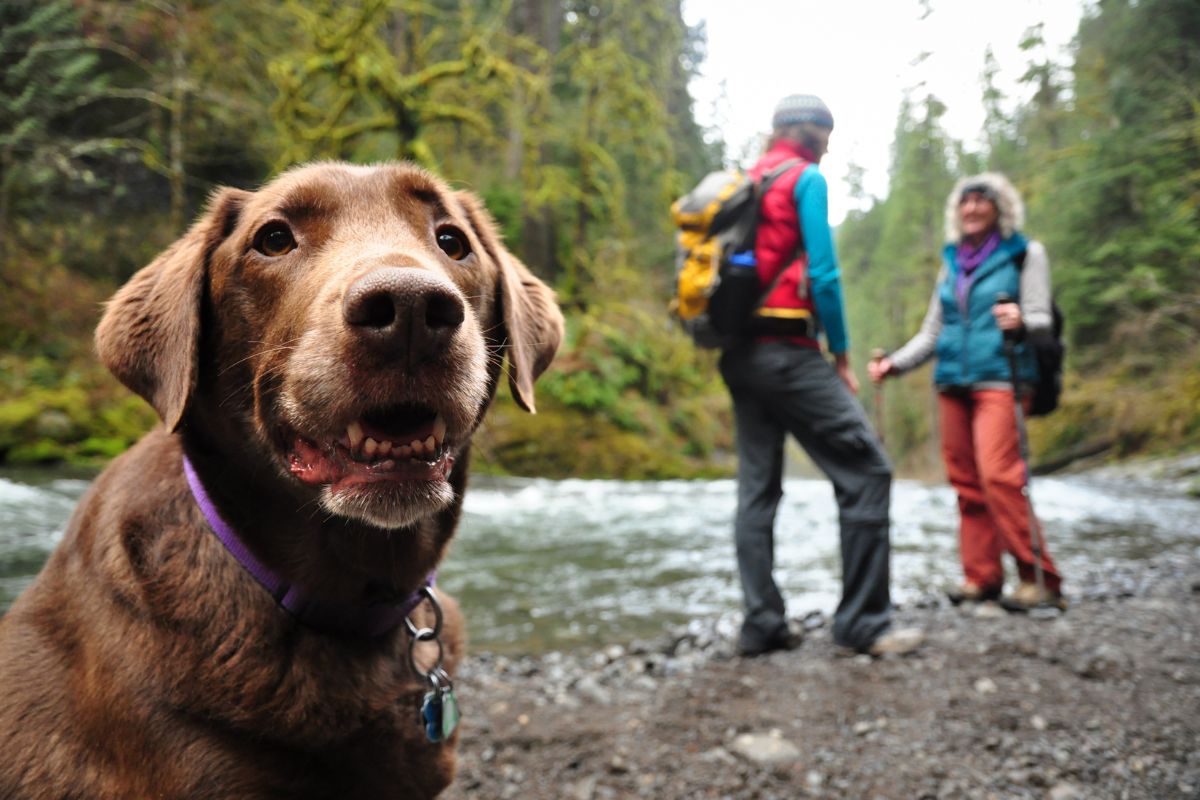Hiking or backpacking with dogs can be an amazing bonding experience with a host of benefits for both you and your canine pal.
Not only will you both enjoy the health benefits of getting some exercise, but it’s a great way to tire your dog out!
And as any dog owner will tell you, a restless dog can be a handful.
In this guide I want to share everything I know about backpacking with dogs:
- How to choose the right hike
- Necessary preparations
- Food and water requirements
- Gear you may need
- Hazards to watch out for
- Basic trail etiquette
As with every article here on The Outdoor Authority, I want to know what you do when backpacking or hiking with dogs.
What types of hikes do you do? What gear do you bring? Do you have any awesome stories from your experiences?
Without further ado, this is our Compete Guide to Backpacking With Dogs.
Table Of Contents
Choose a Dog-Friendly Hike
There are two big considerations when choosing where to backpack with your dog:
- The terrain
- Who owns the land
The terrain
The type of terrain depends a little on your dog, but in general you want to consider a few things:
- Avoid steep or drastically uneven terrain
- Avoid narrow paths on or near ridges
- Avoid excessively hot or cold environments
- Avoid sharp, rocky ground
Softer trails with some natural tree coverage and gentle inclines/declines are best for your dog. It’ll be easier on their paws, prevent overexertion and dehydration, and lessen the risk of fall and injury.
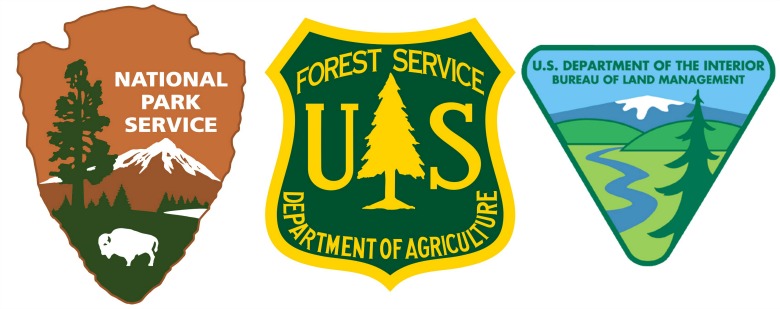
Who owns the land?
Unless you own acres upon acres of undeveloped land, you’ll probably be backpacking on land you don’t own. In general, there are four types of land:
- Local city or state land
- National Parks (owned by United States National Park Service)
- National Forests (owned by United States Forest Service)
- U.S. Bureau of Land Management (BLM) land
And just as the usages are different, so are the leash laws for each type of land ownership.
Local city or state
Land that isn’t federally owned by one of the three agencies below will fall under the purview of your city or state’s government. You’ll have to do the legwork around any regulations regarding letting your dog roam off leash, or whether dogs are allowed at all.
- Where can dogs go? Varies
- Where can’t dogs go? Varies
- Leash restrictions? Varies
National Parks
National Parks are owned by the United States National Parks Service (NPS), an agency of the United States Department of the Interior (DOI), and include many conservation and historical lands and monuments. The purpose of National Parks is conservation, which means there are more restrictions when backpacking with dogs. In total there’s nearly 90 million acres of National Parks, but over half of that is in Alaska alone!
- Where can dogs go? Developed areas, trails, campgrounds, some lodging facilities
- Where can’t dogs go? Public buildings, public transportation, swimming areas
- Leash restrictions? Leash required at all times and not to exceed 6 feet
National Forests
National Forests are owned by the United States Forest Service (USFS), an agency of the United States Department of Agriculture (USDA), and include forests and grasslands. In total there’s nearly 200 million acres of National Forests.
- Where can dogs go? Pretty much everywhere except…
- Where can’t dogs go? Swimming areas
- Leash restrictions? Leash required only in developed areas and not to exceed 6 feet
Bureau of Land Management Land
The BLM is an agency within the United States Department of the Interior (DOI) that administers more federal land than either agency above — about 250 million acres, which is about 1/8 of all land in the United States! However, most of this land is in the western United States and is contained to only 12 different states. Restrictions for hiking and backpacking with dogs on BLM land is the same as USFS land.
- Where can dogs go? Pretty much everywhere except…
- Where can’t dogs go? Swimming areas
- Leash restrictions? Leash required only in developed areas and not to exceed 6 feet
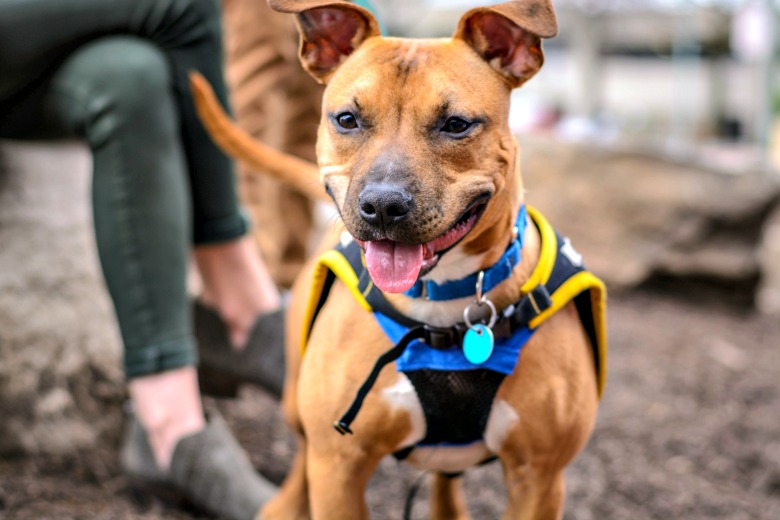
Prepare Your Pup
It might seem like your dog has boundless energy and enthusiasm — ready to tackle the trail at a moment’s notice — but there are a few things you should do in preparation for backpacking with dogs that will make the trip more enjoyable (and safe) for both of you.
Endurance training
Sudden strenuous activity can be dangerous for both humans and dogs. For short hikes you’re probably fine to just get up and go with minor preparations. But for anything long, especially multi-day backpacking trips, you’ll want to work on your dog’s endurance with several progressively longer hikes building up to your target hike distance.
Obedience training
Obedience training is important for four reasons:
- Your safety
- Your dog’s safety
- Safety of passersby
- Everyone’s enjoyment!
As anyone who’s ever taken a dog outside their yard knows, dogs love smelling new things. Your hike is going to be full of new things that just have to be explored. That’s fine! But a well-behaved dog that you’re able to control will prevent them from getting into trouble, prevent you from getting hurt chasing after them, and ensure other people are having a good time too.
Expect to run into other people backpacking with dogs, so make sure your pup can handle potentially having a new friend.
Swim training
Maybe not training per se, but if you’ll be backpacking near water it’s a good idea to make sure your dog (a) is comfortable around water and (b) can swim.
Vet visits and vaccinations
Nature is full of fun and wonder, but it’s also full of parasites that can harm your pup. The good news is that most of these nasties can easily be prevented by making sure you dog is up to date on all vaccinations, such as rabies and distemper. You’ll also want to make sure your dog is up-to-date on its heartworm prevention.
Clip their toenails (and other physical preparations)
Keeping your dog’s toenails in check is an important part of maintaining their physical health. When backpacking with dogs, properly clipped toenails have two benefits:
- More comfortable for your dog, especially if they’re wearing booties
- Won’t tear up your tent if you’re doing multi-day backpacking
You’ll also want to brush your dog well before your hike. Proper brushing serves three purposes:
- Keeps your dog cooler and more comfortable in warm weather
- Removes any local seeds that may be in your dog’s fur, preventing spread of invasive species
- Reduces shedding, which — let’s face it — can be a real mess with some breeds
Food and Water Planning
As a general rule, a dog requires 1 oz of water per 1 lb of body weight for an average day. If you’ll be doing more strenuous backpacking, up that by 33%. The following table should help:

For food, figure on your dog’s normal daily rations plus 50%. If you plan on doing multi-day hiking with long hours and a lot of off-leash time, you may even want to double the daily portion.
It’s also a good idea to bring trail snacks. A little extra dry kibble will be fine, but you could also bring training treats or dehydrated meats.
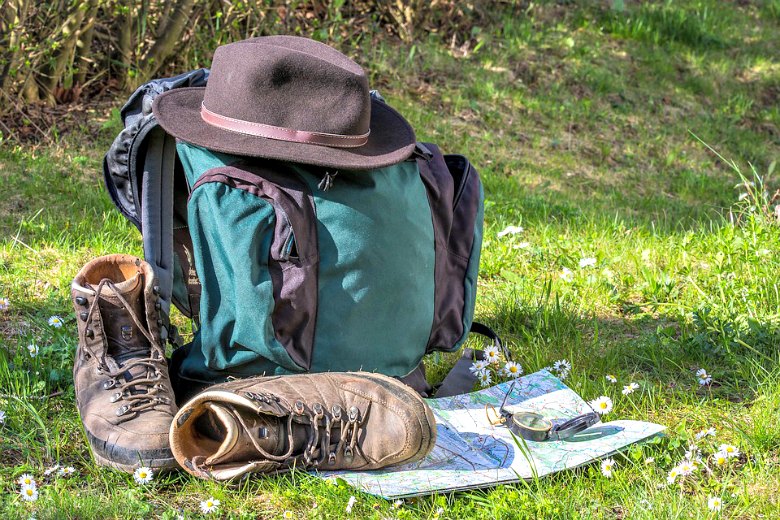
Gear Up!
Backpacking with dogs isn’t too dissimilar from regular ol’ backpacking without dogs — you need some supplies. Many of the usual camping essentials will come in handy when heading out with your pup, but what additional gear might you need?
1. Leash System // Regardless of whether you’re hiking on restrictive National Park land or wide open BLM land, you’re going to need a good leash system. You’ll want a good dog leash for hiking — something more durable — but you may also want to devise a hands-free system. For example, attach a carabiner to your chest area and then attach a leash to that. Just make sure you can wrest control of the reigns when needed. You could also check out a hands-free belt with attached leash.
2. Dog Pack // You love your dog, but don’t let them get away without carrying a load! A saddle-style dog pack can be used to take some of the weight off your shoulders. Just make sure your dog isn’t carrying any more than 1/3 of their body weight. A good dog pack will be lightweight, waterproof, breathable, and have adjustable straps. You can find some good dog packs at on Amazon, such as the OllyDog Trekker.
3. Food and Water // Described in the section above, make sure you bring enough.
4. Collapsible Bowls // You need something to put the food and water in! This collapsible silicon dog bowl comes with carabiners to conveniently clip to your pack.
5. Extra Safety Gear // The unknown wilderness can be a dangerous place, but I think a few safety extras go a long way. Consider attaching a reflective strip to your dog pack or dog collar for better visibility in low light conditions. Also consider a blinking LED light (like a cyclist would wear) or possibly even a bear bell to alert wildlife and passersby to your dog’s presence.
6. Dog Collar // Should your dog wander off, make sure they have a dog collar with proper identification and contact information.
7. First Aid Kit // Hopefully you’re carrying your own First Aid Kit for yourself with all of the standard supplies. If not, at least throw together a kit with these supplies (including a few extras for your pooch):
- Canine toenail clippers
- Canine eyewash
- Canine pain medication
- Tweezers
- Gauze
- Bandage scissors
- Hydrogen peroxide
- Antibiotic ointment (e.g. Bacitracin)
- Adhesive tape
8. Paw Salve // A great way to keep your pup’s paws healthy, a paw salve like Musher’s Secret can provide a little added protection and moisturization.
9. Poop Bags or Trowel // When your dog relieves him or herself, you shouldn’t just leave it be. Even if it’s off the trail, fecal matter can still make water sources unsafe. A general rule is that if you aren’t going to use poop bags to remove it, you should bury it at least 6 inches deep and 200 feet away from water. Because I know you don’t like bringing plastic into nature, try these MUFEI Biodegradable Dog Poop Bags made from vegetable-based material.
10. Brush // While your dog is darting in and out of bushes, they’re probably covering themselves in seeds and sap. Bring a brush to clean them off at the end of your hike. This is especially important to prevent the spread of invasive species.
11. Extra Rope // If you have a carabiner leash system, extra rope can be great to give your dog some running room while still attached to you. It’s also convenient to leash up your dog to a tree or other object when pausing and/or camping for the night.
12. Dog Booties? // Dog booties may not be necessary, but I’d advise giving them a try if you plan on hiking over rocky or hot terrain. These My Busy Dog Water Resistant Boots have reflective Velcro and an anti-slip sole. Note that if you want to get your dog to wear booties on the trail, you’d better let them get used to them before the hike.
Related: Winter Camping With A Dog: Tips To Keep Them Warm & Safe
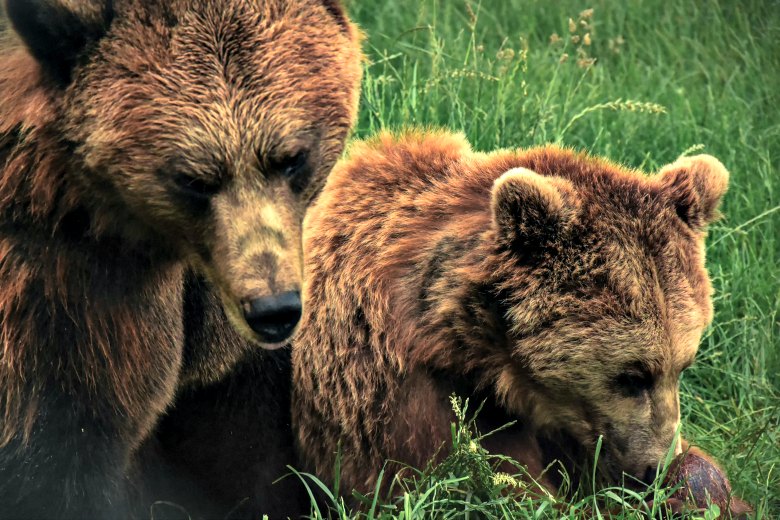
Surviving the Actual Hike
You picked a great hike, prepped your pup, packed your gear, and you hit the trail. You’re having a great time! To ensure you keep having a great time, here are a few things to watch out for.
Overexertion or heatstroke
Dogs just love the Great Outdoors, so much so that they can be prone to overexertion and heatstroke. Make sure you’re stopping regularly to give your dog (and yourself!) a break and some water. There are many signs of heatstroke, but keep an eye out for these ones in particular:
- Panting
- Excessive drooling
- Reddened gums
- Rapid heart rate
- Infrequent urination
- Breathing distress, coughing, or hacking
If you see any of these symptoms, stop immediately and take a long break in a shaded place.
Plants
Your dog will be prancing in and out of bushes, investigating every new scent. They won’t stop to think about what they’re sticking their head into. Familiarize yourself with the hazardous plant-life wherever you’ll be backpacking. I’ll break it up into three categories:
- Irritating (e.g. poison ivy)
- Poisonous (e.g. English Holly)
- Prickly (e.g. burrs)
This great article from the hilariously named YouDidWhatWithYourWeiner.com showcases some of the notable plants in the Pacific Northwest that you should watch out for.
Don’t allow your dog to chew on anything and be careful around things like foxtails, which can wedge themselves in your dog’s snout or between their toes. They look innocent, but they can be painful.
Make sure you brush your dog before and after the hike, and have creams like Benadryl and Hydrocortisone handy should they be needed.
Animals
Just like the dangerous plants above, you should be aware of dangerous animals as well. Bears, snakes, and ticks are the big North American terrors, but in certain areas animals like moose can pose a threat. Regarding ticks, make sure you check your dog when you return from your adventure.
Snake bites
Yes, snakes are animals. But I thought this deserved being called out on its own. Depending on where you’re backpacking, snakes may be a concern. In fact, there are four venomous species in the United States:
- Rattlesnakes: Everywhere except northernmost New England and Midwest
- Copperheads: From PA to AL and as far west as TX
- Water Moccasins (Cotton Mouths): From NC to FL and as far west as TX
- Coral Snakes: From VA to FL and as far west as AZ
Dogs love sticking their noses where they don’t belong, and that could mean a nasty self-defense strike from one of these four snakes. They all like living in tall grass, under brush and leaves, in rock or wood piles, and near water.
Did You Know? It’s estimated that 90% of snake bites occur from April to October, so be on high alert during those months.
It’s unlikely you’ll be hiking with your vet, so you’ll need to provide some basic care until you can find professional help:
- Administer an antihistamine, such as Benedryl
- Administer dog-specific pain medication, such as carprofen
- Keep your dog still and comfortable
Do not apply a tourniquet or attempt to suck out the venom.
Waterborne pathogens
It may seem like your dog has an iron stomach, but they’re susceptible to the same waterborne pathogens we are. Don’t let your dog drink any still water — rushing stream water should be fine — and make sure you stop for frequent water breaks. I’ll assume you’re bringing your own water, but there are also water treatment methods you can use to purify water.
Water, in general
Every dog I’ve ever had has been hydrophilic — they loved water so much it seemed like a magnetic draw. Ponds and lakes are usually pretty safe, provided your dog can swim, but beware if you’ll be backpacking with dogs near water with stronger currents. And if the temperature is cooler or night is approaching, watch out for hypothermia. Make sure you have a towel handy to give you dog a good rubdown.
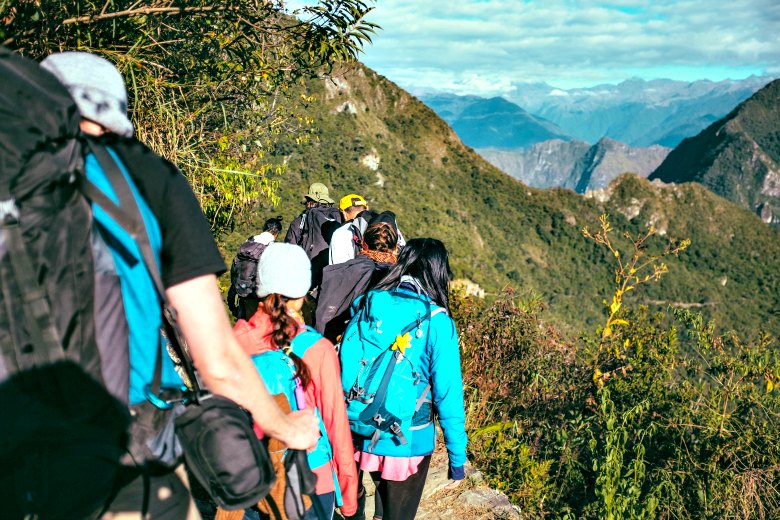
Etiquette When Backpacking With Dogs
Backpacking with dogs can be immensely enjoyable — few things bring a smile to my face like the unbridled joy of man’s best friend. But to ensure that everyone has a great time, there are a few rules of etiquette to consider.
One person, one dog // This ensures you can maintain proper control of your dog, if necessary. It’s also advised you never hike with more than two dogs, as three-plus pooches can become excessively rowdy.
Communicate with other hikers // You love your dog, but not everyone else does. If you see people ahead, let them know your dog is friendly.
Groom before and after // Prevent the spread of invasive species by grooming your dog before you leave your house and after you leave the trail. This helps prevent the spread of seeds to areas they don’t belong.
Clean up after your dog // Don’t dump and dash. No one likes the smell of dog poop, but responsibly packing it up (or burying it sufficiently deep and away from water) is what you sign up for when you go hiking with dogs.
To leash or not to leash // Keep your dog on a leash anywhere near developed land or on trails, even if they’re only lightly trafficked. The only time it’s really OK to go off-leash is if you’re in a truly remote area or an area where unleashing is allowed. You can replicate an unleashed environment by attaching a long length of rope to your dog and just giving them a lot of slack.
Stay on the trail // I’ll be honest — I break this one sometimes. But it’s important to stay on the trail to protect the plant and animal life. If you do choose to venture off trail, tread lightly and be a responsible hiker.
You’re now ready to hike the trail and go hiking with dogs! What tips or tricks can you share from your experiences? Let us know on social media!

